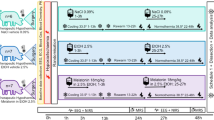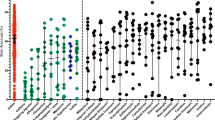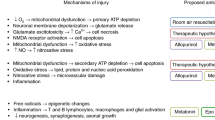Abstract
Objective:
Melatonin has been shown to be neuroprotective in animal models. The objective of this study is to examine the effect of melatonin on clinical, biochemical, neurophysiological and radiological outcomes of neonates with hypoxic–ischemic encephalopathy (HIE).
Study Design:
We conducted a prospective trial on 45 newborns, 30 with HIE and 15 healthy controls. HIE infants were randomized into: hypothermia group (N=15; received 72-h whole-body cooling) and melatonin/hypothermia group (N=15; received hypothermia and five daily enteral doses of melatonin 10 mg kg−1). Serum melatonin, plasma superoxide dismutase (SOD) and serum nitric oxide (NO) were measured at enrollment for all infants (N=45) and at 5 days for the HIE groups (N=30). In addition to electroencephalography (EEG) at enrollment, all surviving HIE infants were studied with brain magnetic resonance imaging (MRI) and repeated EEG at 2 weeks of life. Neurologic evaluations and Denver Developmental Screening Test II were performed at 6 months.
Result:
Compared with healthy neonates, the two HIE groups had increased melatonin, SOD and NO. At enrollment, the two HIE groups did not differ in clinical, laboratory or EEG findings. At 5 days, the melatonin/hypothermia group had greater increase in melatonin (P<0.001) and decline in NO (P<0.001), but less decline in SOD (P=0.004). The melatonin/hypothermia group had fewer seizures on follow-up EEG and less white matter abnormalities on MRI. At 6 months, the melatonin/hypothermia group had improved survival without neurological or developmental abnormalities (P<0.001).
Conclusion:
Early administration of melatonin to asphyxiated term neonates is feasible and may ameliorate brain injury.
This is a preview of subscription content, access via your institution
Access options
Subscribe to this journal
Receive 12 print issues and online access
$259.00 per year
only $21.58 per issue
Buy this article
- Purchase on Springer Link
- Instant access to full article PDF
Prices may be subject to local taxes which are calculated during checkout



Similar content being viewed by others
References
Kurinczuk JJ, White-Koning M, Badawi N . Epidemiology of neonatal encephalopathy and hypoxic-ischaemic encephalopathy. Early Hum Dev 2010; 86 (6): 329–338.
Lawn JE, Kerber K, Enweronu-Laryea C, Cousens S . 3.6 million neonatal deaths—what is progressing and what is not? Semin Perinatol 2010; 34 (6): 371–386.
Shankaran S . Neonatal encephalopathy: treatment with hypothermia. NeoReviews 2010; 11 (2): e85–e92.
Jacobs SE, Berg M, Hunt R, Tarnow-Mordi WO, Inder TE, Davis PG . Cooling for newborns with hypoxic ischaemic encephalopathy. Cochrane Database Syst Rev 2013; 1: CD003311.
Brzezinski A . Melatonin in humans. N Engl J Med 1997; 336 (3): 186–195.
Tamura H, Nakamura Y, Terron MP, Flores LJ, Manchester LC, Tan DX et al. Melatonin and pregnancy in the human. Reprod Toxicol 2008; 25 (3): 291–303.
Weissbluth M . Melatonin increases cyclic guanosine monophosphate: biochemical effects mediated by porphyrins, calcium and nitric oxide. Relationships to infant colic and the sudden infant death syndrome. Med Hypotheses 1994; 42 (6): 390–392.
Chen YC, Tain YL, Sheen JM, Huang LT . Melatonin utility in neonates and children. J Formos Med Assoc 2012; 111 (2): 57–66.
Gitto E, Reiter RJ, Cordaro SP, La Rosa M, Chiurazzi P, Trimarchi G et al. Oxidative and inflammatory parameters in respiratory distress syndrome of preterm newborns: beneficial effects of melatonin. Am J Perinatol 2004; 21 (4): 209–216.
Gitto E, Karbownik M, Reiter RJ, Xian Tan D, Cuzzocrea S, Chiurazzi P et al. Effects of melatonin treatment in septic newborns. Pediatr Res 2001; 50 (6): 756–760.
Gitto E, Romeo C, Reiter RJ, Impellizzeri P, Pesce S, Basile M et al. Melatonin reduces oxidative stress in surgical neonates. J Pediatr Surg 2004; 39 (2): 184–189.
Alonso-Alconada D, Alvarez A, Arteaga O, Martinez-Ibarguen A, Hilario E . Neuroprotective effect of melatonin: a novel therapy against perinatal hypoxia-ischemia. Int J Mol Sci 2013; 14 (5): 9379–9395.
Reiter RJ, Tan DX, Osuna C, Gitto E . Actions of melatonin in the reduction of oxidative stress: a review. J Biomed Sci 2000; 7 (6): 444–458.
Rodriguez C, Mayo JC, Sainz RM, AntolÃn I, Herrera F, MartÃn V et al. Regulation of antioxidant enzymes: a significant role for melatonin. J Pineal Res 2004; 36 (1): 1–9.
Reiter RJ, Calvo JR, Karbownik M, Qi W, Tan DX . Melatonin and its relation to the immune system and inflammation. Ann NY Acad Sci 2000; 917: 376–386.
Mohan N, Sadeghi K, Reiter RJ, Meltz ML . The neurohormone melatonin inhibits cytokine, mitogen and ionizing radiation induced NF-κB. Biochem Mol Biol Int 1995; 37 (6): 1063–1070.
Radogna F, Diederich M, Ghibelli L . Melatonin: a pleiotropic molecule regulating inflammation. Biochem Pharmacol 2010; 80 (12): 1844–1852.
Mayo JC, Sainz RM, Tan DX, Hardeland R, Leon J, Rodriguez C et al. Anti-inflammatory actions of melatonin and its metabolites, N1-acetyl-N2-formyl-5-methoxykynuramine (AFMK) and N1-acetyl-5-methoxykynuramine (AMK), in macrophages. J Neuroimmunol 2005; 165 (1-2): 139–149.
Kaur C, Sivakumar V, Lu J, Tang FR, Ling EA . Melatonin attenuates hypoxia-induced ultrastructural changes and increased vascular permeability in the developing hippocampus. Brain Pathol 2008; 18 (4): 533–547.
Carloni S, Perrone S, Buonocore G, Longini M, Proietti F, Balduini W . Melatonin protects from the long-term consequences of a neonatal hypoxic-ischemic brain injury in rats. J Pineal Res 2008; 44 (2): 157–164.
Robertson NJ, Faulkner S, Fleiss B, Bainbridge A, Andorka C, Price D et al. Melatonin augments hypothermic neuroprotection in a perinatal asphyxia model. Brain 2013; 136 (1): 90–105.
Sarnat HB, Sarnat MS . Neonatal encephalopathy following fetal distress. A clinical and electroencephalographic study. Arch Neurol 1976; 33 (10): 696–705.
Jacobs SE, Morley CJ, Inder TE, Stewart MJ, Smith KR, McNamara PJ et al. Whole-body hypothermia for term and near-term newborns with hypoxic-ischemic encephalopathy: a randomized controlled trial. Arch Pediatr Adolesc Med 2011; 165 (8): 692–700.
Fourtillan JB, Brisson AM, Fourtillan M, Ingrand I, Decourt JP, Girault J . Melatonin secretion occurs at a constant rate in both young and older men and women. Am J Physiol Endocrinol Metab 2001; 280 (1): E11–E22.
Merchant NM, Azzopardi DV, Hawwa AF, McElnay JC, Middleton B, Arendt J et al. Pharmacokinetics of melatonin in preterm infants. Br J Clin Pharmacol 2013; 76 (5): 725–733.
Nebot C, Moutet M, Huet P, Xu JZ, Yadan JC, Chaudiere J . Spectrophotometric assay of superoxide dismutase activity based on the activated autoxidation of a tetracyclic catechol. Anal Biochem 1993; 214 (2): 442–451.
Biagioni E, Mercuri E, Rutherford M, Cowan F, Azzopardi D, Frisone MF et al. Combined use of electroencephalogram and magnetic resonance imaging in full-term neonates with acute encephalopathy. Pediatrics 2001; 107 (3): 461–468.
Barkovich AJ, Hajnal BL, Vigneron D, Sola A, Partridge JC, Allen F et al. Prediction of neuromotor outcome in perinatal asphyxia: evaluation of MR scoring systems. AJNR Am J Neuroradiol 1998; 19 (1): 143–149.
Miller SP, Ramaswamy V, Michelson D, Barkovich AJ, Holshouser B, Wycliffe N et al. Patterns of brain injury in term neonatal encephalopathy. J Pediatr 2005; 146 (4): 453–460.
Frankenburg WK, Dodds J, Archer P, Shapiro H, Bresnick B . The Denver II: a major revision and restandardization of the Denver Developmental Screening Test. Pediatrics 1992; 89 (1): 91–97.
Hallioglu O, Topaloglu AK, Zenciroglu A, Duzovali O, Yilgor E, Saribas S . Denver developmental screening test II for early identification of the infants who will develop major neurological deficit as a sequalea of hypoxic-ischemic encephalopathy. Pediatr Int 2001; 43 (4): 400–404.
Kumar A, Ramakrishna SV, Basu S, Rao GR . Oxidative stress in perinatal asphyxia. Pediatr Neurol 2008; 38 (3): 181–185.
Tomas-Zapico C, Coto-Montes A . A proposed mechanism to explain the stimulatory effect of melatonin on antioxidative enzymes. J Pineal Res 2005; 39 (2): 99–104.
Thorat VN, Suryakar AN, Sardeshmukh AS, Sarawade SS . Oxidants and antioxidants in hypoxic ischaemic encephalopathy. Indian J Clin Biochem 2004; 19 (2): 32–35.
Kakita H, Hussein MH, Kato S, Yamada Y, Nagaya Y, Asai H et al. Hypothermia attenuates the severity of oxidative stress development in asphyxiated newborns. J Crit Care 2012; 27 (5): 469–473.
Fulia F, Gitto E, Cuzzocrea S, Reiter RJ, Dugo L, Gitto P et al. Increased levels of malondialdehyde and nitrite/nitrate in the blood of asphyxiated newborns: reduction by melatonin. J Pineal Res 2001; 31 (4): 343–349.
Author information
Authors and Affiliations
Corresponding author
Ethics declarations
Competing interests
The authors declare no conflict of interest.
Rights and permissions
About this article
Cite this article
Aly, H., Elmahdy, H., El-Dib, M. et al. Melatonin use for neuroprotection in perinatal asphyxia: a randomized controlled pilot study. J Perinatol 35, 186–191 (2015). https://doi.org/10.1038/jp.2014.186
Received:
Revised:
Accepted:
Published:
Issue Date:
DOI: https://doi.org/10.1038/jp.2014.186
This article is cited by
-
The predictive value of MRI scores for neurodevelopmental outcome in infants with neonatal encephalopathy
Pediatric Research (2024)
-
Comparison of Different Adjuvant Therapies for Hypothermia in Neonates with Hypoxic-Ischemic Encephalopathy: A Systematic Review and Network Meta-Analysis
Indian Journal of Pediatrics (2024)
-
Significance of Melatonin in the Regulation of Circadian Rhythms and Disease Management
Molecular Neurobiology (2024)
-
Melatonin or its analogs as premedication to prevent emergence agitation in children: a systematic review and meta-analysis
BMC Anesthesiology (2023)
-
Neuroprotective therapies in the NICU in term infants: present and future
Pediatric Research (2023)



